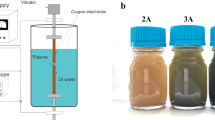Abstract
A method for synthesis of copper oxide nanoparticles in a reactor for low-pressure arc discharge synthesis is presented, and the effect that the oxygen content of the gas mixture fed into the reactor has on the ratio between CuO and Cu2O phases is studied. The crystalline structure of synthesized copper oxide nanoparticles is investigated by X-ray diffraction (XRD), and the particle morphology is characterized using transmission electron microscopy. The growth of nanoparticles during synthesis in arc discharge plasma is investigated using optical emission spectroscopy. XRD analysis shows that the proportion of the Cu2O phase decreases with increasing oxygen content of the gas mixture. The photocatalytic properties of the prepared Cu2O nanopowder are evaluated by carrying out the decomposition reaction of methyl orange dye in an aqueous medium.





Similar content being viewed by others

REFERENCES
Khela, R. And Bodnarova, L., Possible efficiency testing of TiO2 photocatalyst in concrete, Stroit. Mater., 2015, no. 2, pp. 77–81.
Jiang, D., Xue, J., Wu, L., Zhou, W., Zhang, Y., and Li, X., Photocatalytic performance enhancement of CuO/Cu2O heterostructures for photodegradation of organic dyes: Effects of CuO morphology, Appl. Catal., B, 2017, vol. 211, pp. 199–204. https://doi.org/10.1016/j.apcatb.2017.04.034
Arshadi-Rastabi, S., Moghaddam, J., and Eskandarian, M.R., Synthesis, characterization and stability of Cu2O nanoparticles produced via supersaturation method considering operational parameters effect, J. Ind. Eng. Chem., 2015, vol. 22, pp. 34–40. https://doi.org/10.1016/j.jiec.2014.06.022
Haider, A.J., AL-Anbari, R.H., Kadhim, G.R., and Salame, C.T., Exploring potential environmental applications of TiO2 nanoparticles, Energy Procedia, 2017, vol. 119, pp. 332–345. https://doi.org/10.1016/j.egypro.2017.07.117
Shakibania, R., Kinetic model for nanocrystalline anatase to rutile polymorphic transformation, Chem. Biochem. Eng. Q., 2017, vol. 31, pp. 353–359.
Fedorov, L.Yu., Karpov, I.V., Ushakov, A.V., Lepeshev, A.A., Shaikhadinov, A.A., and Demin, V.G., Physico-chemical properties of nanodispersed zirconium dioxide obtained in a low-pressure plasma chemical reactor, Materialovedenie, 2014, no. 10, pp. 37–42.
Ushakov, A.V., Karpov, I.V., Lepeshev, A.A., Petrov, M.I., Fedorov, L.Yu., Gokhfel’d, D.M., Zharkov, S.M., Zeer, G.M., Demin, V.G., and Abkaryan, A.K., The influence of CuO dopant nanoparticles, prepared via the arc plasma synthesis method, on the critical current of YBa2Cu3O7 – σ composites, Inorg. Mater.: Appl. Res., 2019, vol. 10, no. 4, pp. 999–1002. https://doi.org/10.1134/S2075113319040439
Chepkasov, I.V., Gafner, Y.Y., and Gafner, S.L., Synthesis of Cu nanoparticles by condensation from the gas phase, Phase Transitions, 2017, vol. 90, pp. 590–597.
Jin, Y., Chen, J., Fu, Q., Li, B., Zhang, H., and Gong, Y., Low-temperature synthesis and characterization of helical carbon fibers by one-step chemical vapor deposition, Appl. Surf. Sci., 2015, vol. 324, pp. 438–442. https://doi.org/10.1016/j.apsusc.2014.10.107
Jiang, D., Xing, C., Liang, X., Shao, L., and Chen, M., Synthesis of cuprous oxide with morphological evolution from truncated octahedral to spherical structures and their size and shape-dependent photocatalytic activities, J. Colloid Interface Sci., 2016, vol. 461, pp. 25–31.
Beshkar, F., Khojasteh, H., and Salavati-Niasari, M., Flower-like CuO/ZnO hybrid hierarchical nanostructures grown on copper substrate: Glycothermal synthesis, characterization, hydrophobic and anticorrosion properties, Materials, 2017, vol. 1, pp. 697.
Srivastava, S. and Agarwal, A., Influence of co doping on structural and optical properties of CuO nanoparticles, J. Ovonic Res., 2018, vol. 14, pp. 395–404.
Funding
This work was supported by the Russian Foundation for Basic Research (project no. 18-48-242005), the Government of Krasnoyarsk Krai, and the Krasnoyarsk Krai Science Foundation (auxiliary agreement no. 11/18) within the scope of the research project “Mathematical Modeling of Coupled Physical Processes in Dynamic Plasma Systems in a Vacuum Arc Reactor.”
Author information
Authors and Affiliations
Corresponding author
Additional information
Translated by A. Kukharuk
Rights and permissions
About this article
Cite this article
Ushakov, A.V., Karpov, I.V., Fedorov, L.Y. et al. Formation of CuO and Cu2O Crystalline Phases in a Reactor for Low-Pressure Arc Discharge Synthesis. Inorg. Mater. Appl. Res. 11, 232–237 (2020). https://doi.org/10.1134/S2075113320010372
Received:
Revised:
Accepted:
Published:
Issue Date:
DOI: https://doi.org/10.1134/S2075113320010372



